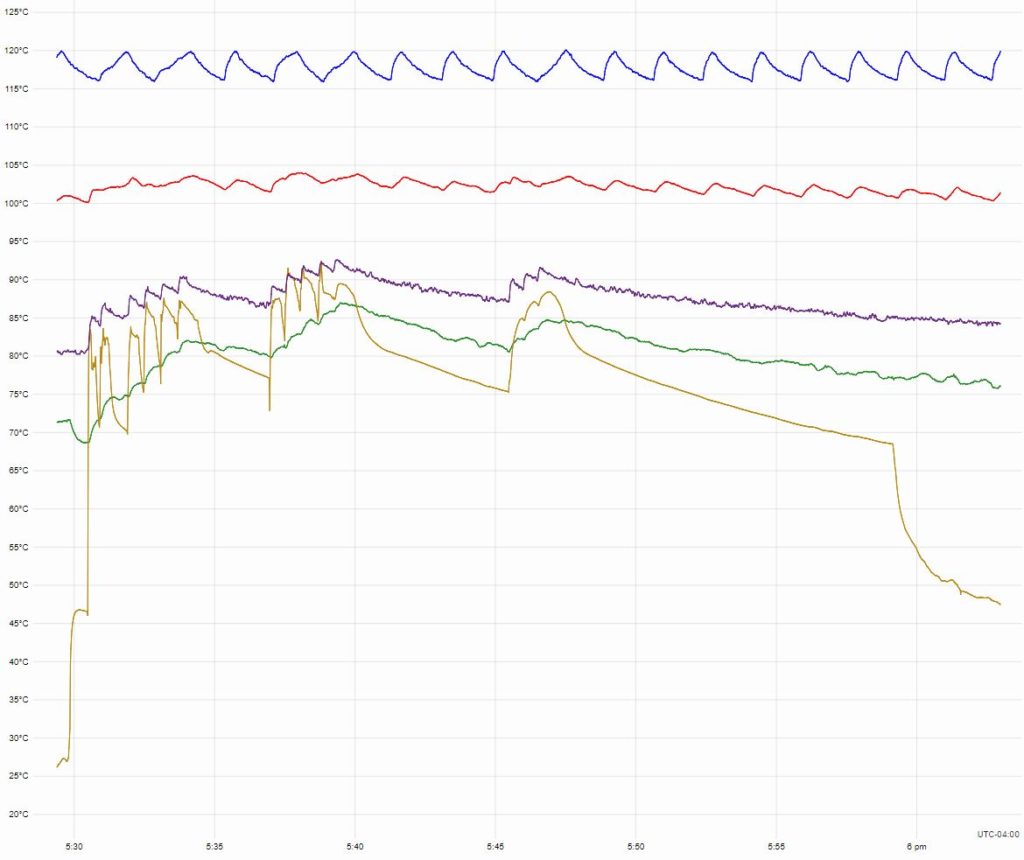
[Ed: Re-post from April 29 2018]
So, if a pressure profile is a cat among pigeons around here, here’s a fox in the hen house:


What are we looking at? This is a multi-channel temperature log of my early 80s [Brugnetti Aurora] horseshoe HX machine over a period of about half an hour.
Methodology:
Five K-type thermocouples were installed on the boiler, the side of the brew reservoir, the group neck (i.e. extension between the bolt flange and the body of the group), the outside of the portafilter holder on the group and the puck inside the pseudo-Scace. The machine was turned on at roughly 10am and was at idle for at least one hour before the test. The pressurestat is set so that the average boiler pressure is in middle of the recommended band (the green area on the Brugnetti gauge) at 0.9 bar.
At 5:30pm the portafilter was inserted cold into the holder and 6 simulated shots were pulled with the needle valve set to give 20-30 seconds of flow per shot. The spacing of the shots is very quick – about 30 seconds apart – much faster than a ‘worst case’ scenario of constant use in a commercial setting.
At 5:34pm the machine was left to idle for 3 minutes then a further 5 shots were pulled.
At 5:40pm the machine idled for 5 minutes and 3 shots were pulled.
At 5:59pm the portafilter was removed.
Limitations of the methodology:
A) The pseudo-Scace is by no means a perfect analog to actual coffee for a number of reasons:
First, the Acetal puck, although vaguely similar, does not conduct heat in the same way as coffee grounds.
Second, the puck gains heat from shot to shot unlike coffee, which will always be at (close to) room temperature.
Thirdly, the flow rate through the needle valve is not very repeatable.
Fourthly, fluid flow through real coffee is unlikely to be linear, and this non-linearity is not modeled with the needle valve.
So temperature readings “at the puck” should be taken with a grain of salt.
That being said, for comparative study of different machines, Scace-like instruments are a valuable tool.
B) Also, with the except of the pseudo-Scace, these measurements are surface temperatures not actual water temperature.
Observations:
- The roughly triangular wave of the boiler (blue line) is from the pressurestat controller with roughly 0.2 bar of hysteresis (dead band). Total variation is approximately 4 degrees C.
- The (red) brew reservoir temperature (and by inference also the water inside it) correlates closely with the boiler temperature but the variation is considerable damped. Total brew reservoir variation is less than 1.5 C.
- Average (or baseline) temperature of the brew reservoir is affected only very slightly by continual use rising from 100.5 C at idle to 102.5 C after intense activity.
- Neck temperature (purple) seems to be a better analog to puck temperature than the outside of the portafilter holder.
- The group gains heat with each shot if not left enough time to recover and (based on a small sample of only two points on the group) the heat gain is uniform throughout the group.
- With the exception of the walk-up shot with a cold PF, the temperature gain of the group is between 1.5 C and 2.5 C per shot.
- Group recovery time – that is, the time it takes for the group to cool from any given temperature gain – is about 67 seconds per degree C of temperature gain.
- Puck temperature (bearing in mind the caveats above) is lower than expected, especially for the walk-up shot – but the results in the cup are known to be good with this machine at these settings.
Conclusions:
- Brew reservoir temperature demonstrates a relatively high degree of stability even with a dead band of more than 20% of the operating pressure setpoint.
- Group temperature should be stable if correctly managed. If the machine is left to idle between shots for a reasonable amount of time (between 2 and 3 minutes – i.e. not inconsistent with the time it takes to prepare a shot), it will return to its initial temperature and provide repeatable shot temperatures.
- The methodology should be changed for future tests to reflect a more realistic real-world usage with a sufficiently long period of time between shots.
- Not bad for 1982.
